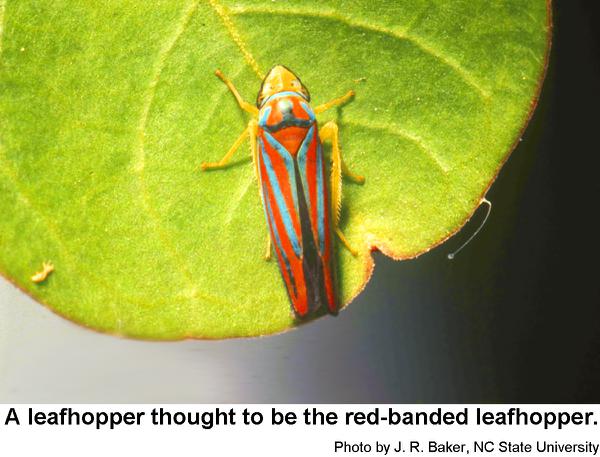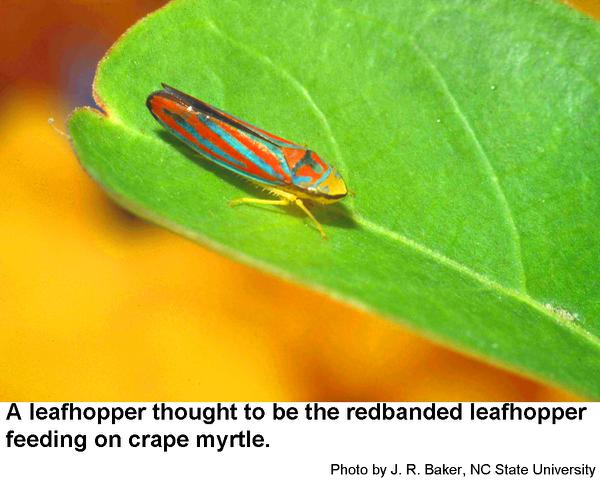Description and Biology
The redbanded leafhopper, Graphocephala coccinea, is also called the candy-striped leafhopper as well as the red-and-blue leafhopper, red-banded leafhopper, scarlet-and-green leafhopper because of its bright red and blue (or green) markings on the wings and thorax. Its head, legs and under parts are bright yellow. These leafhoppers are usually 1/4 to 5/16 inch long. They frequent woodlands, meadows, and landscapes. Leafhoppers suck out sap from leaves and stems. They expel excess sugars and liquids forcefully as tiny droplets. Leafhopper adults typically emerge in spring and after feeding and mating, lay eggs in leaf veins, shoots and stems.Eggs hatch about 10 days later. Nymphs are wingless and gradually grow wing pads as they molt and grow. Adults appear about a month later (sometimes more quickly in hot weather). We probably have more than one generation per year in North Carolina.
Host Plants
Redbanded leafhoppers feed on fruit bushes and ornamental plants including crapemyrtle, rhododendron, roses, and Scotch broom. As this leafhopper uses its mouthpart to pierce and suck plant sap, it also injects its saliva. It can transmit Pierce’s Disease (leaf scorch) to grape, oak, elm, sycamore, and other trees and shrubs.
Residential Recommendations
Control of redbanded leafhoppers is complicated in that they fly (and hop) readily so that ornamental plants may be re-infested shortly the application of an insecticide of short residual activity such as insecticidal soaps, neem extracts, horticultural oils, and even Sevin. That being written, because of its huge feral population, this leafhopper will probably never develop resistance to insecticides so that any insecticide labeled for home landscape use should give more than adequate control. Consider using a pyrethroid insecticide because pyrethroids are effective for such leaf feeders, they have a long residual life on the plant, and they are relatively safe for humans and pets when used as directed (but they are really toxic to fish!). Pyrethroids labeled for residential landscapes are readily available in most big box stores, plant centers, and nurseries. Active ingredients of any pesticide are listed on the front label of any pesticide package by law—usually in very small font near the bottom of the label. The active ingredients of pyrethroid insecticides all end with "-thrin."
References
- Candy-Striped Leafhopper - (Graphocephala coccinea). Staff Writer, 2017. Insect Identification for the casual observer.
- Checklist of Leafhopper Species 1758-1955 (Hemiptera: Membracoidea: Cicadellidae and Myserslopiidae) with Synonymy and Distribution. McKaney, S. H. 2013. USDA Agricultural Research Service, Systematic Entomology Laboratory.
- Graphocephala coccinea (Forster, 1771), Red-banded Leafhopper,
Scarlet-and-green leafhopper; Candy-striped leafhopper. Anonymous. 2022 (updated). Discover Life. - Red-banded leafhopper (Graphocephala coccinea). Colon, A? No Date. Minnesota Seasons.com.
- Red-banded Leafhopper. Pavade, N. 2015. UC Davis Art-Science Fusion: Painting & Entomology.
- Extension Plant Pathology Publications and Factsheets
- Horticultural Science Publications
- North Carolina Agricultural Chemicals Manual
For assistance with a specific problem, contact your local Cooperative Extension Center.
This Factsheet has not been peer reviewed.
Publication date: Sept. 22, 2017
Reviewed/Revised: June 30, 2022
Recommendations for the use of agricultural chemicals are included in this publication as a convenience to the reader. The use of brand names and any mention or listing of commercial products or services in this publication does not imply endorsement by NC State University or N.C. A&T State University nor discrimination against similar products or services not mentioned. Individuals who use agricultural chemicals are responsible for ensuring that the intended use complies with current regulations and conforms to the product label. Be sure to obtain current information about usage regulations and examine a current product label before applying any chemical. For assistance, contact your local N.C. Cooperative Extension county center.
N.C. Cooperative Extension prohibits discrimination and harassment regardless of age, color, disability, family and marital status, gender identity, national origin, political beliefs, race, religion, sex (including pregnancy), sexual orientation and veteran status.


